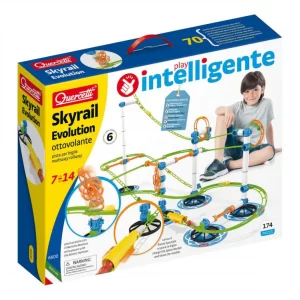Sensory play is essential for the development of young children. The sooner we can introduce children to various sensory items, the better. Incorporating a sensory object into sensory play may help youngsters learn about many forms of sensory input and improve their sensory integration.
A sensory toy is meant to excite several senses. Further, sensory toys are very enticing to youngsters since they entertainingly provide multiple sensory experiences. While most of these toys are designed to engage the five primary senses, which include sight, hearing, smell, and touch, a handful emphasises body awareness and balance.
Let’s understand what sensory play is and how sensory toys help.
What Is Sensory Play?
Essentially, sensory play involves engaging any of your child’s senses. So this encompasses the senses of touch, smell, sight, and taste. However, it also covers mobility, equilibrium, and spatial awareness. A child’s senses are not completely developed at birth. As infants, toddlers, and preschoolers experience the sensory world, only then do they grow. Further, each new encounter with a distinct sense creates nerve connections that expand the brain’s architecture.
Sensory play emphasises activities that stimulate your child’s senses, fostering the development of language and motor abilities. Additionally, it promotes cognitive development, social relationships, and exploration.
Sensory play may also address our proprioceptive and vestibular systems, which are often neglected.
Our proprioception sense relates to our physical awareness. It informs us about the relative positions of our body parts and the force required while holding, moving, pulling, or lifting something.
Our vestibular sense, our movement or balance sense, enables us to maintain equilibrium throughout physical activity.
The Role Of Sensory Toys
1. Engaging all Senses
People often see sand and water tables or children experimenting with clay and playdough when they consider sensory play. But it’s not just about touch; it also involves the other senses.
Examples of engaging your child’s senses include:
- The harsh smell of vinegar in a scientific experiment.
- The hues of water during a colour mixing experiment.
- The texture and fragrance of a scratch-and-sniff artwork.
2. Language Skills
Playing with various textures, tastes, and objects helps your youngster develop a new vocabulary for describing the environment. Further, providing children with sensory toys helps them to discuss new textures and forms. Hence this fosters language practice and the usage of words linked with the objects or tasks they are engaged with.
3. Fine Motor Skills
Your kid develops two primary kinds of motor abilities: fine and gross motor skills. Gross motor skills include the coordination of vast muscular groups and are necessary for running, walking, etc.
Fine motor skills involve the use and coordination of tiny muscle groups. These are necessary for shoe-tying, writing, buttoning, and zipping. Fine motor skills are commonly used and developed during sensory play by exploring toys and other things with pinching, pouring, and lacing motions.
4. Calming Effect
You may have observed that your child is calmed after a bath or following a particularly intense round of bouncing about the room, collapsing into his bed or pillows.
This sort of sensory play is soothing for children because it helps them control their inner discomfort, whether it is restlessness, hyperactivity, or another form of agitation.
5. Cognitive Stimulation
Sensory play enhances brain growth, memory, and the capacity to do more complicated activities. Further, it enhances hand-eye coordination.
6. Interpersonal Interaction
Toys that stimulate the senses allow young children to play more interactively. Therefore it fosters social skills such as sharing/taking turns, communication, decision-making, and self-assurance.
7. Awareness
Active sensory play aids in developing a child’s perception of their environment and greater awareness.
8. Offers Additional Stimulation
As stated previously, sensory toys give children sensory stimulation. So this is vital for fostering self-awareness in children. In addition, these toys assist your kid in developing a relationship with the outside world.
Some children require additional classroom engagement to focus. Small toys stimulating the senses may help youngsters concentrate and be more productive in educational settings.
9. Arouses curiosity for learning.
Creating an engaging approach for newborns to learn leads to more pleasure, which may encourage an interest in education.
10. Improves Focus
Children with sensory impairments may have difficulty focusing. Here, sensory toys play a significant part in enhancing kids’ concentration. So the skill helps children with learning disorders concentrate on their tasks.
Types Of Sensory Toys Available
There are several sensory toys available for purchase. However, choosing the appropriate one based on your child’s requirements and interests is essential.
Various sensory systems may be used to classify children’s sensory toys. Some toys enable the simultaneous exploration of numerous senses. Allowing your youngster to engage in sensory play throughout the day may aid in developing their senses. The following are kinds of sensory toys:
1. Visual Toys
Visual toys are excellent for helping toddlers improve their visual abilities, such as tracking and visual perception.
Toys with a visual component may help children remain calm and attentive and can be utilised as an effective soothing technique. You may use a variety of visual toys to help them relax.
2. Tactile Toys
Tactile toys, particularly fidget toys, help youngsters develop their fine and gross motor skills and tactile development.
Feeling varied textures, such as rough and silky, helps keep your toddler interested in exploring varied textures. It also helps kids develop hand-eye coordination as they seek the toys and use the product’s many components.
Children who are sensory searchers and demand increased sensory input might benefit from tactile toys. For older children, tactile toys may help them concentrate for longer periods in the classroom.
3. Auditory Sensory Toys
Auditory sensory toys facilitate the development of auditory processing in children. Additionally, they may be good for people who are sensitive to loud sounds. These toys encourage your child’s interactive exploration of new sounds. Further, they enhance their comfort with auditory cues.
Conclusion
As you introduce sensory toys to your youngster, ensure they are comfortable with them. For children on the autism spectrum, sensory toys provide a variety of advantages. Some toys may relax and quiet a youngster who is overstimulated. Other toys teach youngsters about the environment around them and the consequences of their actions. Additionally, sensory toys may aid in developing motor abilities, especially oral motor skills.
Sister Sensory offers a range of sensory toys. Browse our store to learn more about our range.







